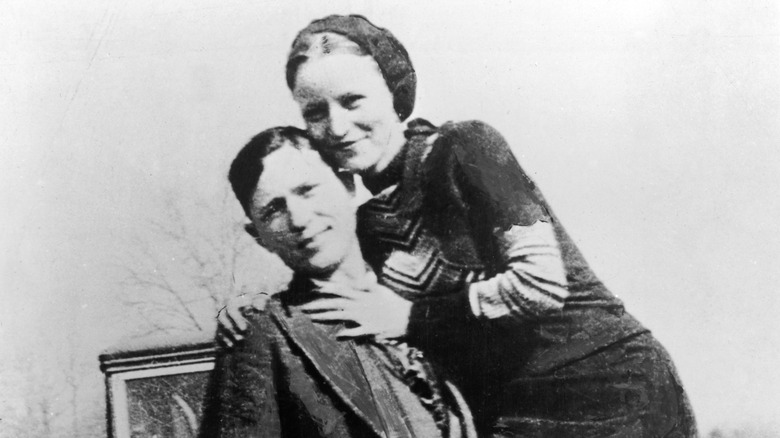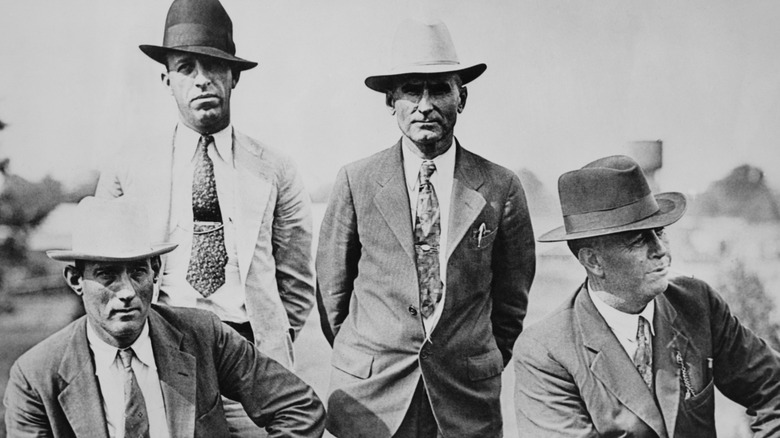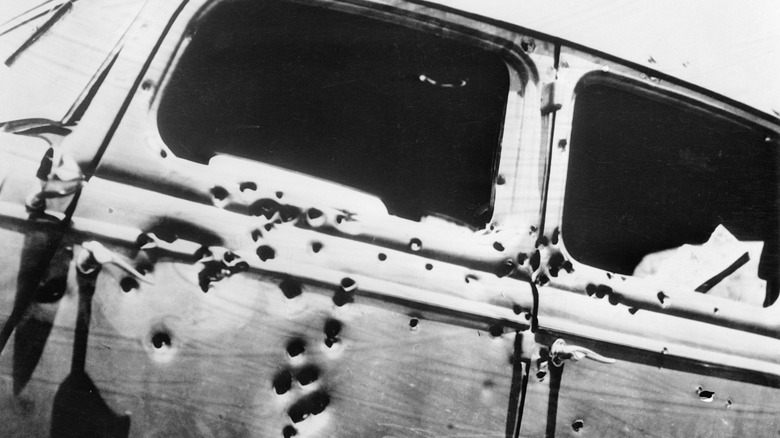Here's How Much The Bounty On Bonnie And Clyde Was Really Worth
Bonnie Parker and Clyde Barrow took a fatalistic attitude toward their life of crime. Biographers have noted that they felt sure the law would catch up to them sooner or later, and Parker's poetry included verses predicting their deaths. But after a horrific stint at Eastham Prison Farm, Barrow was resolved never to end up back in prison. Parker was committed to Barrow and was enticed by the notoriety their criminal activities brought her. And operating as they did during both the Great Depression and the tail-end of Prohibition, their prospects for a better life appeared nonexistent.
Within their lifetime and for decades after, Parker and Barrow were romanticized as a dashing pair of outlaw lovers, targeting banks and living like Robin Hood. In reality, most of their robberies were of small businesses that got them just enough cash to scrape by in increasingly desperate circumstances. Notoriously, their crimes included around a dozen counts of murder, those they killed included both policemen and innocent bystanders. Their brutal 1934 murders of nonviolent officers in Grapevine, Texas, while exaggerated in the press, was brutal enough to turn public opinion against the pair, particularly Parker, who had up until then not been portrayed as a violent criminal.
In the wake of the Grapevine murders, several rewards were offered for anyone who could apprehend Parker and Barrow. According to Jeff Guinn's book "Go down together: the true, untold story of Bonnie and Clyde," Governor Ma Ferguson of Texas set a bounty of $500 for the pair of them, while highway patrol superintendent L.G. Phares offered $1,000 — notably, only for their dead bodies. Adjusted for inflation, in 2024 the bounties were worth nearly $11,800 and $24,000 respectively.
The men who killed Bonnie and Clyde were promised $26,000
Clyde Barrow had lived with a price on his head for longer than Bonnie Parker by 1934. According to a 1934 Daily News story, the state of Missouri had offered $1,000 for the capture of Barrow and his brother the year before, and the Texas legislature voted to put a $1,000 price on his head just months before the Grapevine murders. The bounties posted after Grapevine were the first to implicate Parker in violent crime.
Former Texas Ranger Frank Hamer, on authority from Texas prison superintendent Lee Simmons, began hunting down Parker and Barrow after they freed five convicts from Barrow's hated Eastham Prison. It was a solitary mission for Hamer until the Grapevine murders energized the case. Hamer recruited friend and active ranger Ben Maney Gault to aid him in tracking the robbers' movements and patterns, and they received additional help from the FBI, local law enforcement officers, and the family of an accomplice of Barrow's, Henry Methvin. It was thanks to the family's information that Hamer was able to set his ambush for Parker and Barrow.
Hamer and Gault reportedly wanted to take their targets alive, but in the confusion set off by a passing logger truck, the May 23, 1934 trap became one of the most infamous gun battles between cops and robbers in modern American history. Six men, including Hamer and Gault, were involved in the shootout. Among them was Dallas deputy Ted Hinton, who was later told by his sheriff, Smoot Schmid, that the combined value of the bounties on Parker and Barrow came to $26,000, per "Go Down Together," a sum worth of nearly $619,000 as of 2024.
Bonnie and Clyde's killers never got the full bounty
When Dallas County Sheriff Smoot Schmid claimed that the various rewards for Bonnie Parker and Clyde Barrow added up to $26,000, he initially suggested that it would be split among the six men who killed them. But his arithmetic depended on various pledges by private businesses and various state and local governments. Once Parker and Barrow were dead, many of these organizations decided that they couldn't or wouldn't pay up.
The bounties set immediately after the Grapevine murders weren't forthcoming either. L.G. Phares's $1,000 reward depended on public contributions, and The Galveston Daily News reported that $2,800 was raised by the time Parker and Barrow were killed. But payment of that bounty became subject to ballistic tests on the bullets used in the shootout.
In the end, the lawmen involved in bringing down Parker and Barrow were paid $200.23 each, or roughly $4,760 as of 2024. Frank Hamer supplemented this slim reward with the gradual sale of Parker and Barrow's gun collection. Per Biography, he and Ben Maney Gault both came to resent the attention heaped upon them as the men who led the hunt against the notorious Bonnie and Clyde and kept tight-lipped about the affair in public until their respective deaths.


